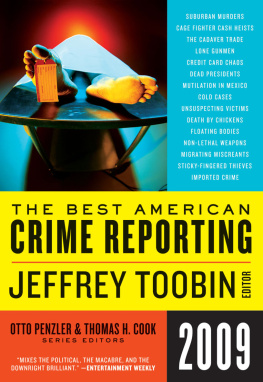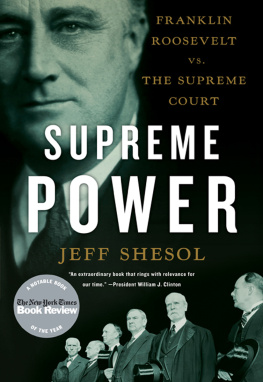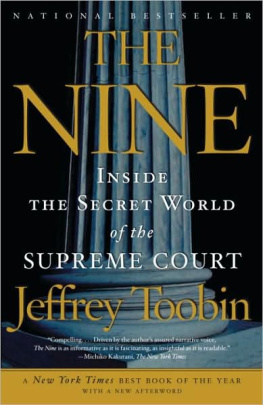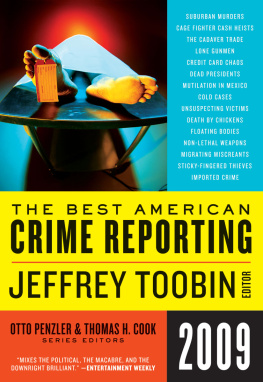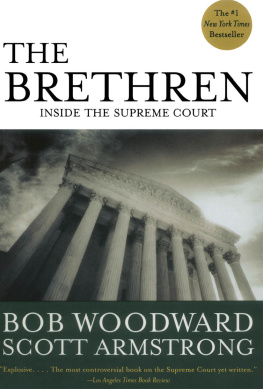
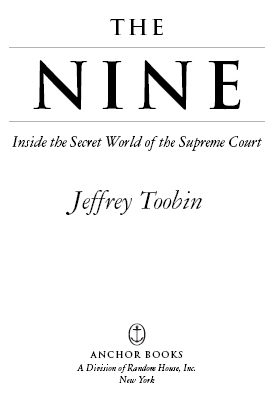
CONTENTS

Praise for Jeffrey Toobins
THE NINE
Winner of the J. Anthony Lukas Book Prize for Excellence in Nonfiction
The Nine not only provides a vivid narrative history of the Courts recent history, but also gives the reader an intimate look at individual justices, showing how personality, judicial philosophy and personal alliances can inform decisions that have huge consequences for the entire country. Driven by the authors assured narrative voice, The Nine is as informative as it is fascinating, as insightful as it is readable.
Michiko Kakutani, The New York Times
Every decade or so, an enterprising and intelligent outsider like Toobin can come along and shine a much-needed spotlight on the place. The Nine is engaging, erudite, candid and accessible, often hard to put down. Toobin is a natural storyteller, and the stories he tells are gripping. [He] writes about the court more fluidly and fluently than anyone.
David Margolick, The New York Times Book Review
The Nine is the latest, and by far the best [book]about the Supreme Court.
Nina Totenberg, NPR
This is a remarkable, riveting book. So great are Toobins narrative skills that both the justices and their inner world are brought vividly to life.
Doris Kearns Goodwin
[An] absorbing group profile. [Toobin] deftly distills the issues and enlivens his narrative of the Courts internal wranglings with sharp thumbnail sketches
Publishers Weekly
A compelling look at the power and the politics behind the Supreme Court.
Booklist
A major achievement, lucid and probing.
Bob Woodward
PART

FOUR

PART

THREE

PART

TWO

PART

ONE

PROLOGUE

THE STEPS
T he architect Cass Gilbert had grand ambitions for his design of a new home for the Supreme Courtwhat he called the greatest tribunal in the world, one of the three great elements of our national government. Gilbert knew that the approach to the Court, as much as the structure itself, would define the experience of the building, but the site presented a challenge. Other exalted Washington edificesthe Capitol, the Washington Monument, the Lincoln Memorialinspired awe with their processional approaches. But in 1928 Congress had designated for the Court a cramped and asymmetrical plot of land, wedged tightly between the Capitol and the Library of Congress. How could Gilbert convey to visitors the magnitude and importance of the judicial process taking place within the Courts walls?
The answer, he decided, was steps. Gilbert pushed back the wings of the building, so that the public face of the building would be a portico with a massive and imposing stairway. Visitors would not have to walk a long distance to enter, but few would forget the experience of mounting those forty-four steps to the double row of eight massive columns supporting the roof. The walk up the stairs would be the central symbolic experience of the Supreme Court, a physical manifestation of the American march to justice. The stairs separated the Court from the everyday worldand especially from the earthly concerns of the politicians in the Capitoland announced that the justices would operate, literally, on a higher plane.
That, in any event, was the theory. The truth about the Court has always been more complicated.
For more than two hundred years, the Supreme Court has confronted the same political issues as the other branches of governmentwith a similar mixed record of success and failure. During his long tenure as chief justice, John Marshall did as much as the framers of the Constitution themselves to shape an enduring structure for the government of the United States. In the decades that followed, however, the Court fared no better than presidents or the Congress in ameliorating the horror of slavery or avoiding civil war. Likewise, during the period of territorial and economic expansion before World War I, the Court again shrank from a position of leadership, mostly preferring to accommodate the business interests and their political allies, who also dominated the other branches of government. It was not until the 1950s and 1960s, and the tenure of Chief Justice Earl Warren, that the Court consistently asserted itself as an independent and aggressive guarantor of constitutional rights.
For the next thirty years, through the tenures of Chief Justices Warren E. Burger and William H. Rehnquist, the Court stood nearly evenly divided on the most pressing issues before it. On race, sex, religion, and the power of the federal government, the subjects that produced the enduring controversies, control of the Court generally belonged to the moderate swing justices, first Lewis F. Powell and then Sandra Day OConnor, who steered the Court in line with their own cautious instinctswhich were remarkably similar to those of the American people. The result was a paradox. Like all their predecessors, the justices belonged to a fundamentally antidemocratic institution. They were not elected; they were not accountable to the public in any meaningful way; their life tenure gave them no reason to cater to the will of the people. Yet the touch-stones of the years 1992 to 2005 on the Supreme Court were decisions that reflected public opinion with great precision. The opinions were issued in the Courts customary language of legal certaintyannounced as if the constitutional text and precedents alone mandated their conclusionsbut the decisions in these cases probably would have been the same if they had simply been put up for a popular vote.
That, now, may be about to change. Through the tense standoff of the Burger and Rehnquist years, a powerful conservative rebellion against the Court was building. It has been, in many respects, a remarkable ideological offensive, nurtured at various times in such locales as elite law schools, evangelical churches, and, most importantly and most recently, the White House. Its agenda has remained largely the same over the decades. Reverse
Next page



